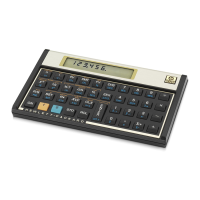110
Section 10
Program Editing
There are various reasons why you might want to modify a program you have
stored in Program memory: to correct a program that turns out to have errors; to
insert new instructions such as ? to store intermediate results or u to
display intermediate results; or to replace a u instruction by an t
instruction.
Rather than clearing program memory and keying in the modified program, you
can modify the program already stored in the calculator. This is called program
editing.
Changing the Instruction in a Program Line
To change a single instruction in program memory:
1. Press fs to set the calculator to Program mode.
2. Use Ê, Ü, or i. to set the calculator to the program line
preceding the line containing the instruction to be changed.
3. Key in the new instruction.
For example, to change the instruction stored in program line 005, press
gi.004, then key in the new instruction that is to be stored in program
line 005. The instruction previously stored in line 005 will be replaced; it is not
automatically “bumped” into line 006.
Example: With the last program from the preceding section still stored in the
calculator, suppose you wanted to use register R
2
for some other purpose, and so
you needed to replace the :2 instruction in program line 005 with, say, :6.
You could change the instruction in line 005 as follows:
Keystrokes(RPN mode) Display
fs
000,
Sets calculator to Program mode.
gi.004
004,43,33,007
Sets calculator to program line
preceding that containing the
instruction to be changed.
:6
005, 45 6
Keys new instruction into
program line 005, replacing the
:2 instruction previously
there.
Ê
006,43,33,008
Shows that instruction in program
line 006 has not been changed.

